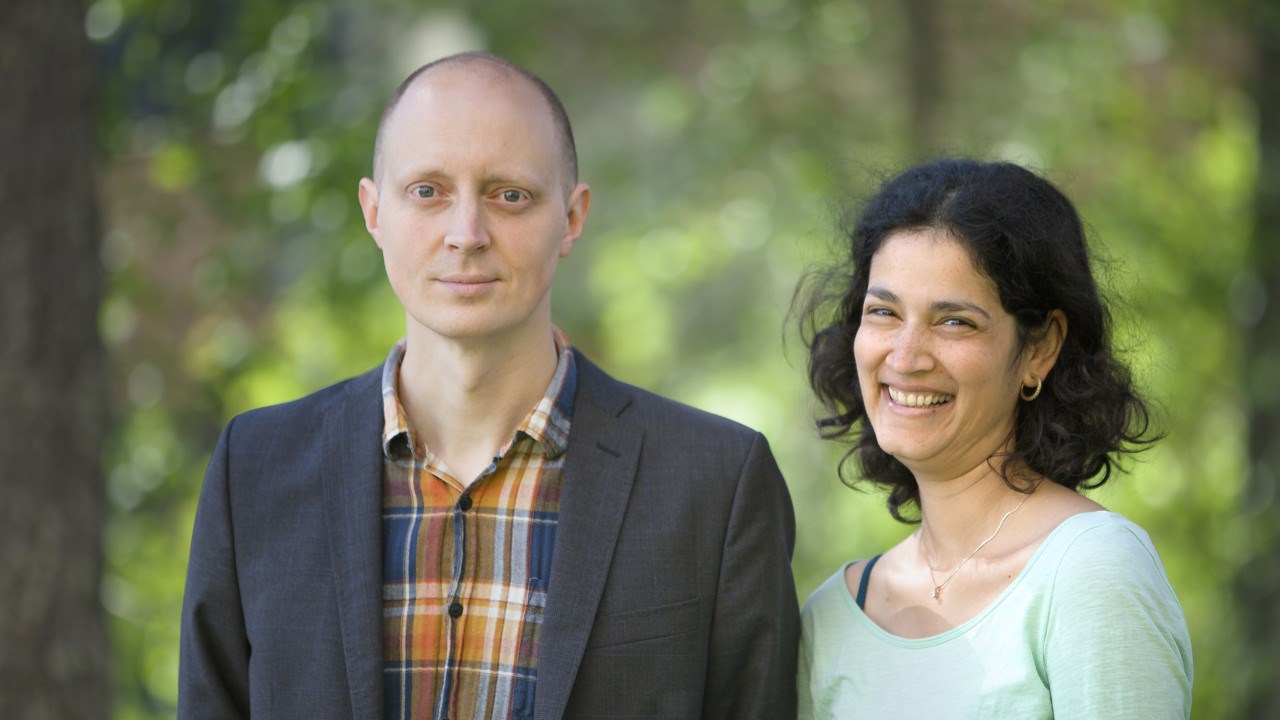NEWS What is beauty in mathematics? Researchers Manya Raman-Sundström and Lars-Daniel Öhman are tackling this issue with great enthusiasm.

Lars-Daniel Öhman and Manya Sundström, mathematicians: “We talk very little about school mathematics and beauty so students may not know that mathematics can be beautiful.”
PhotoMattias PetterssonIf you talk to mathematicians, they often express themselves in terms of beauty; that this is what has made them carry on doing mathematics or that it has had an impact on their choice of research subject. Today, however, we know quite a bit about the concept of beauty, but there is a burgeoning interest in the field of research that brings together philosophers, mathematicians and aesthetes both in Sweden and internationally.
"The feeling of beauty is difficult to describe," says Manya Raman-Sundström. It's not as simple and immediate as it is with music. A beautiful calculation is an experience you have to work with. It can lead to a really enlightening experience that generates a deeper feeling that stays with you throughout your life, such as the explanation of the Pythagorean theorem.
The mathematical explanation does not necessarily have to be visually pleasing," Lars-Daniel Öhman continues. "But often things are interconnected."
"You can think of beauty as something that "fits" just like a piece of a puzzle. Once you find the logical context between ideas, you know that an established result is correct. The natural solution provides a satisfactory aesthetic kick," he says.
Pascal's triangle is a simple example of beauty in mathematics. It is a geometric representation of the binomial coefficients in the form of a triangle. The proof is beautiful and understanding the logic and aesthetics can result in the observer having a WOW experience.
There is a certain degree of conformity among mathematicians about what are beautiful proofs and this amazes Lars-Daniel and Manya.
"It suggests that beauty in mathematics, at least on some level, is objective. Mathematicians are experts in different fields and they find their favourites among theorems and proofs, but it is not at all unusual that these favourites are those that other mathematicians can also appreciate," says Manya.
She believes that there is more stability in the concept of beauty in mathematics than in art.
"It may be because we all receive a coherent education in mathematics, but to have access to experiences in "The Gallery of Mathematics" you need to have enough baggage of mathematical knowledge," she says and likens it to "if you yourself can dance, the experience of a dance performance will be that much deeper."
The more knowledge you have, the more you can see and experience, seems to apply. But does this mean that the great experiences of beauty are only available to a small group of specialised mathematicians? Can children also appreciate the beauty of mathematics in similar ways?
"It's an open question that we are also intending to study. At school and even at university level, it is rarely the case that one encounters this type of teaching. We talk very little about school mathematics and beauty so students may not know that mathematics can be beautiful," says Manya.
Therefore, she and Lars-Daniel have plans to gather different beautiful mathematical proofs and derivations in a collection of examples directed towards primary and secondary schools. In this way, the teacher will have help in conveying these types of experiences to their students.
"We have talked to some teachers and some understand the concept and are enthusiastic, while others are completely silent".
In earlier research, it has been suggested that the mathematical thinking of students consists of three components: cognitive, affective (motivation) and aesthetic. Most of the research into the didactics of mathematics has always concerned the cognitive aspect, but during the past 20 years the affective aspect has also been addressed by many researchers. In principal, the aesthetic dimension is still unexplored.
"An important starting point is that all three elements are linked. One should preferably not forget the link between the aesthetic and the cognitive aspect, which many mathematicians talk about," says Lars-Daniel.
Five to ten years ago, some researchers in different countries began to seriously study the beauty of mathematics. The fact that Manya began to take an interest in the topic was purely coincidental.
"I was sick and lying on the coach at home reading a philosophical book about beauty. I thought why not apply this to math too? When I got better, I contacted my colleague Lars-Daniel at the Department of Mathematics and presented my ideas".
That was three years ago. Now they have started a scientific activity in short space of time. The two researchers have organised a series of seminars and last spring they arranged an international workshop at Umeå University that gathered many top researchers in the field – philosophers, mathematicians and didactic mathematicians.
"We complement each other very well," says Lars-Daniel. I have a doctorate in discrete mathematics while Manya has focused on the didactics of mathematics. And naturally we are both philosophically inclined!"
The two young scientists, who seem to be a close-knit team, have the time and ambition to develop their field of research. Although their research is still at an early stage, they believe that it has the potential to change our view of curricula in mathematics, and it touches on many open questions, including how beauty is represented in the brain and what beauty is.
Educational development work at school is one of the goals.
"A prerequisite for this is that we can provide a concrete account of what beauty in mathematics is and convey that feeling. Today there are courses in appreciating art or wine, perhaps in the future we will offer courses in appreciating mathematics," says Lars-Daniel.